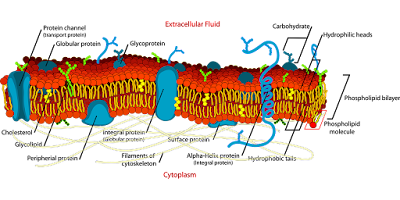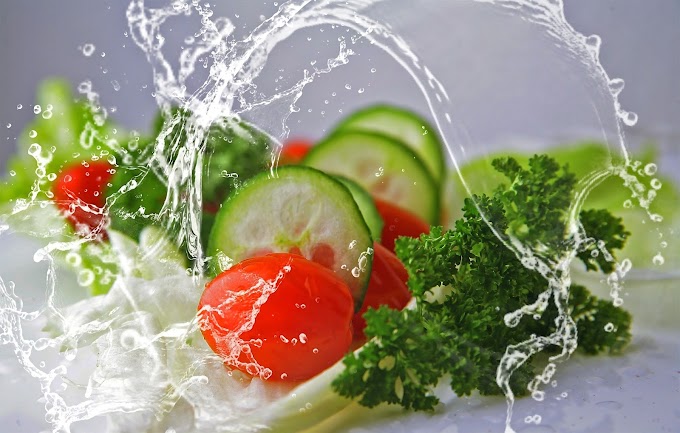 |
| Movement across Membranes The Glycocalyx shows the Glycoproteins and glycolipids. Note that all of the attached carbohydrates are on the outside of the plasma membrane. |
Movement across Membranes:
Molecules show different types of Movement across Membranes. Molecules can cross membranes in a number of ways, both by using their own energy and by relying on an outside energy source.
Simple Diffusion:
Molecules move randomly (due to spontaneous molecular motions) from areas where they are highly concentrated to areas of lower concentration until they are evenly distributed in a state of dynamic equilibrium. This process is Simple Diffusion. Simple diffusion accounts for most of the short-distance transport of substances moving into and out of cells.
Facilitated Diffusion:
Polar molecules (not soluble in lipids) may diffuse through protein channels (pores) in the lipid bilayer. The protein channels offer a continuous pathway for specific molecules to move across the plasma membrane so that they never come into contact with the hydrophobic layer of the membrane's polar surface.
Large molecules and some of those not soluble in lipids require assistance in passing across the plasma membrane. These molecules use facilitated diffusion, which, like simple diffusion requires no energy input. To pass across the membrane, a molecule temporarily binds with a carrier (transport) protein in the plasma membrane and is transported from an area of higher concentration to one of lower concentration.
Osmosis:
The diffusion of water across a selectively permeable membrane from an area of higher concentration to an area of lower concentration is osmosis. Osmosis is just a special type of diffusion, not a different method.
The term tonicity refers to the relative concentration of solutes in the water inside and outside the cell. For example, in an isotonic solution, the solute concentration is the same inside and outside a red blood cell. The concentration of water molecules is also the same inside and outside the cell. Thus, water molecules move across the plasma membrane at the same rate in both directions, and there is no net movement of water in either direction.
In a hypertonic solution, the solute concentration is higher outside the red blood cell than inside. Because the concentration of water molecules inside the cell is higher than outside, water moves out of the cell, which shrinks. This condition is called crenation in red blood cells.
In a hypotonic solution, the solute concentration is lower outside the red blood cell than inside. Conversely, the concentration of water molecules is higher outside the cell than inside. As a result, water moves into the cell, which swells and may burst.
Filtration:
Filtration is a process that forces small molecules across selectively permeable membranes with the aid of hydrostatic (water) pressure (or some other externally applied force, such as blood pressure). For example, in the body of an animal such as a frog, filtration is evident when blood pressure forces water and dissolved molecules through the permeable walls of small blood vessels called capillaries.
In filtration, large molecules, such as proteins, do not pass through the smaller membrane pores. Filtration also takes place in the kidneys when blood pressure forces water and dissolved wastes out of the blood vessels and into the kidney tubules in the first step in urine formation.
Active Transport:
Active-transport processes move molecules and other substances across a selectively permeable membrane against a concentration gradient_ that is, from an area of lower concentration to one of higher concentration. This movement against the concentration gradient requires ATP energy. The active transport process is similar to facilitated diffusion, except, that the carrier protein in the plasma membrane must use energy to move the molecules against their concentration gradient.
One active transport mechanism, the sodium-potassium pump, helps maintain the high concentrations of potassium ions inside nerve cells that are necessary for the transmission of electrical impulses. Another active-transport mechanism, the calcium pump, keeps the calcium concentration hundreds of times lower inside the cell than outside.
Endocytosis:
Another process by which substances move across the plasma membrane is endocytosis. Endocytosis involves the bulk movement of materials across the plasma membrane, rather than the movement of individual molecules. The three forms of endocytosis are pinocytosis, phagocytosis, and receptor-mediated endocytosis.
Pinocytosis is the nonspecific uptake of small droplets of extracellular fluid. Any small solid dissolved in the fluid is also taken into the cell. Pinocytosis occurs when a small portion of the plasma membrane indents (invaginations). The open end of the invagination seals itself off, forming a small vesicle. This tiny vesicle detaches from the plasma membrane and moves into the cytoplasm.
Phagocytosis is similar to pinocytosis, except that the cell takes in solid material rather than liquid. Commonly, an organelle called a lysosome combines with the vesicle to form a phagolysosome, and lysosomal digestive enzymes break down the vesicle's contents.
Receptor-mediated Endocytosis involves a specific receptor protein on the plasma membrane that " recognizes" an extra-cellular molecule and binds with it. This reaction somehow stimulates the membrane to indent and create a vesicle containing the selected molecule. A variety of important molecules (such as cholesterol) are brought into cells in this manner.
Exocytosis:
An organelle known as the Golgi apparatus packages proteins and other molecules that the cell produces into vesicles for secretion. In the process of exocytosis, these secretory vesicles fuse with the plasma membrane and release their contents into the extracellular environment. this process adds new membranes which replaces the plasma membrane lost during endocytosis.







If you have any doubt, let me know.